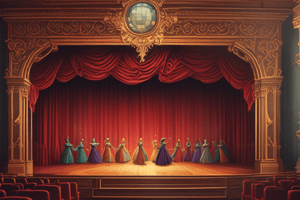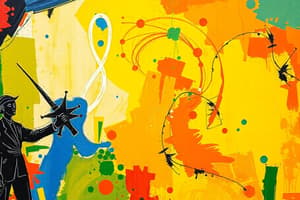Podcast
Questions and Answers
What is a key aspect to discuss with the director before the first rehearsal?
What is a key aspect to discuss with the director before the first rehearsal?
- Special needs for the production (correct)
- The actors' performances from previous plays
- The audience's expectations
- Financial budget for the production
What is a common component of most first rehearsals?
What is a common component of most first rehearsals?
- Costume fittings
- Audience feedback sessions
- Read through of the script (correct)
- Set construction planning
How should the director's preferences for the rehearsal structure be approached?
How should the director's preferences for the rehearsal structure be approached?
- With personal judgments about effectiveness
- With flexibility and openness to their wishes (correct)
- With strict adherence to a pre-planned schedule
- With a demand for outlined objectives in advance
What should be prioritized when communicating with the actors regarding the rehearsal schedule?
What should be prioritized when communicating with the actors regarding the rehearsal schedule?
What might the director want to do during the first rehearsal aside from a read through?
What might the director want to do during the first rehearsal aside from a read through?
Why is making a good first impression during the first rehearsal important?
Why is making a good first impression during the first rehearsal important?
How should the assistant director respond to the director's rehearsal demands?
How should the assistant director respond to the director's rehearsal demands?
What element is crucial for the assistant director to clarify with the director regarding equipment?
What element is crucial for the assistant director to clarify with the director regarding equipment?
What items should be set out at each actor's station before their arrival?
What items should be set out at each actor's station before their arrival?
What is one of the primary roles of the director at the beginning of rehearsal?
What is one of the primary roles of the director at the beginning of rehearsal?
What should the stage manager confirm about the rehearsal schedule?
What should the stage manager confirm about the rehearsal schedule?
What typically varies between directors regarding the stage manager's involvement during a read through?
What typically varies between directors regarding the stage manager's involvement during a read through?
What action should the stage manager take to track the duration of the first read through?
What action should the stage manager take to track the duration of the first read through?
During the rehearsal, what is important for the costume designer to do?
During the rehearsal, what is important for the costume designer to do?
Which types of stage directions are generally not read by the stage manager according to most directors?
Which types of stage directions are generally not read by the stage manager according to most directors?
What is a practical reason for the director and stage manager to coordinate before the first read through?
What is a practical reason for the director and stage manager to coordinate before the first read through?
What does the symbol 'x' represent in the blocking notation?
What does the symbol 'x' represent in the blocking notation?
Which symbol represents 'sit' in the blocking notation?
Which symbol represents 'sit' in the blocking notation?
What should you use for making blocking notations?
What should you use for making blocking notations?
How does the notation indicate the first move on any page?
How does the notation indicate the first move on any page?
Which of the following is not a symbol used in the described blocking notation?
Which of the following is not a symbol used in the described blocking notation?
What does the curved arrow in the notation signify?
What does the curved arrow in the notation signify?
What does the ampersand symbol (&) represent in the initials notation?
What does the ampersand symbol (&) represent in the initials notation?
If the first move on a page is character Ben crossing stage right and sitting, how would you denote this?
If the first move on a page is character Ben crossing stage right and sitting, how would you denote this?
What is the primary responsibility of the stage manager at the end of the meeting?
What is the primary responsibility of the stage manager at the end of the meeting?
Why is it important for the stage manager to ensure everyone understood the meeting discussions?
Why is it important for the stage manager to ensure everyone understood the meeting discussions?
How should the stage manager decide on symbols for characters?
How should the stage manager decide on symbols for characters?
What should a stage manager do if there are multiple characters with names starting with the same letter?
What should a stage manager do if there are multiple characters with names starting with the same letter?
What is essential to do before adjourning the meeting?
What is essential to do before adjourning the meeting?
What aspect of blocking can vary between stage managers?
What aspect of blocking can vary between stage managers?
What might a stage manager do to differentiate between three characters with names starting with 'S'?
What might a stage manager do to differentiate between three characters with names starting with 'S'?
What should be included at the beginning of the script for reference?
What should be included at the beginning of the script for reference?
What does the notation 'b' signify in the movement description?
What does the notation 'b' signify in the movement description?
How can a cross be indicated if it is made downstage of a chair?
How can a cross be indicated if it is made downstage of a chair?
What notation should be added if a new move occurs between two existing moves?
What notation should be added if a new move occurs between two existing moves?
What is indicated by an up arrow above the chair symbol?
What is indicated by an up arrow above the chair symbol?
What does the notation 'abx' signify when describing an actor's movement?
What does the notation 'abx' signify when describing an actor's movement?
Why is it important to keep a key for symbols used in blocking?
Why is it important to keep a key for symbols used in blocking?
How do you know which character is moving in the notation?
How do you know which character is moving in the notation?
What does the 'light slash off' notation imply in the blocking?
What does the 'light slash off' notation imply in the blocking?
Flashcards
Pre-Rehearsal Prep
Pre-Rehearsal Prep
Collaborating with the director to identify production-specific needs like props and costumes, and discussing rehearsal structure.
Actor Communication
Actor Communication
Clearly informing actors about the rehearsal schedule and expectations.
First Rehearsal Structure
First Rehearsal Structure
Often includes a read-through, potentially exploring other activities like research or improvisation.
Actor's Station Setup
Actor's Station Setup
Signup and view all the flashcards
Director/Designer Interaction
Director/Designer Interaction
Signup and view all the flashcards
Rehearsal Schedule Distribution
Rehearsal Schedule Distribution
Signup and view all the flashcards
Stage Directions Read-Through
Stage Directions Read-Through
Signup and view all the flashcards
Read-Through and Timing
Read-Through and Timing
Signup and view all the flashcards
Meeting Documentation
Meeting Documentation
Signup and view all the flashcards
Blocking Notation System
Blocking Notation System
Signup and view all the flashcards
Character Symbols in Blocking
Character Symbols in Blocking
Signup and view all the flashcards
Blocking Notation Key
Blocking Notation Key
Signup and view all the flashcards
Symbols for Actions/Objects
Symbols for Actions/Objects
Signup and view all the flashcards
Flexibility in Blocking
Flexibility in Blocking
Signup and view all the flashcards
Supplemental Blocking Notations
Supplemental Blocking Notations
Signup and view all the flashcards
Movement Notations and Script
Movement Notations and Script
Signup and view all the flashcards
Directional Arrows in Blocking
Directional Arrows in Blocking
Signup and view all the flashcards
Dynamic Blocking Key
Dynamic Blocking Key
Signup and view all the flashcards
Evolving Blocking
Evolving Blocking
Signup and view all the flashcards
Performance Calendar
Performance Calendar
Signup and view all the flashcards
Production Meeting Notes
Production Meeting Notes
Signup and view all the flashcards
Contact Sheet
Contact Sheet
Signup and view all the flashcards
Contact Card
Contact Card
Signup and view all the flashcards
Sharpened Pencil
Sharpened Pencil
Signup and view all the flashcards
Study Notes
Pre-Rehearsal Preparation
- Collaborate with the director to identify any production-specific needs, such as additional props or costume changes not in the script.
- Discuss the structure of the first rehearsal, including elements like read-throughs, design presentations, and research time.
- Confirm any special equipment the director may require, such as a CD player.
Communication with Actors
- Inform actors of the rehearsal schedule promptly and courteously, establishing yourself as the primary point of contact.
- Prepare actors for the expectations and format of the rehearsal to create a positive first impression and foster a good working relationship.
First Rehearsal Structure
- The first rehearsal typically includes a read-through, although some directors may opt for research activities or improvisation during the initial days.
- Utilize the first rehearsal to solidify team dynamics as actors meet each other and the stage manager.
Actor's Station Setup
- At each actor's station, organize essential materials: performance calendar, contact sheet, contact card, and sharpened pencil for ease of access.
Director and Designer Interaction
- Allow the director ample time to discuss the production choices and artistic vision with the entire team.
- Designers should present their designs, explaining the rationale behind their choices to the cast.
Rehearsal Schedule Distribution
- Clarify how actors will receive the rehearsal schedule, ensuring communication methods are established for posting or calling.
Stage Directions and Read-Throughs
- Discuss with the director about reading stage directions during the read-through; preferences vary with some directors wanting all and others preferring just key directions.
- Use a stopwatch to track time, as initial read-throughs often reflect close performance time.
Meeting Documentation
- Compile and summarize all decisions, questions, and requests from production meetings into production meeting notes to distribute to attendees.
- Ensure the next meeting's date is established before concluding each meeting.
Blocking Notation Techniques
- Develop a personalized blocking notation system, combining various methods learned from others with original ideas.
- Use symbols for each character, typically the first letter of their name, adapting as necessary for similar initials.
- Create a key for symbols in the script for clarity in notation.
Specific Symbols for Blocking
- Implement unique symbols for actions and objects; for example:
- "x" for crossing the stage, "s" with a tail for sit, "r" for rise, chair and table symbols for furniture.
- Document blocking notations side-by-side with the text to maintain consistency and context of character movements.
Flexibility in Blocking
- Recognize that blocking is not static; adjustments can and should be made as needed during rehearsals.
- Create a method to indicate supplemental movements within your existing notation system (e.g., using "a1" for an added move).
Detailed Movement Notations
- Structure notations to reflect character movements in tandem with script references, ensuring clarity and ease of adjustments.
- Use directional arrows to denote upstage/downstage movements in relation to furniture placements.
Continual Development of Symbols
- Keep a dynamic key for symbols and movements, allowing for easy updates as new directions are introduced during rehearsals.
- Tailor the blocking process based on the evolving dynamics of the rehearsal, adapting symbols and notation techniques to suit the production's needs.
Studying That Suits You
Use AI to generate personalized quizzes and flashcards to suit your learning preferences.




